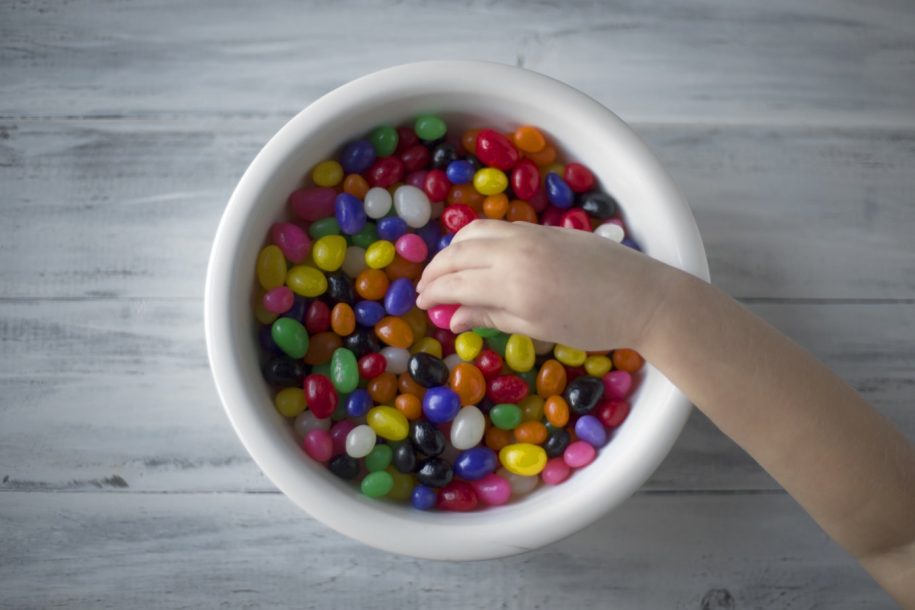Sugar and your child’s behaviour
By Allison Riehs | Naturopath
If you think your child is extra hyperactive after colourful breakfast cereals, lollies at grandma’s house or sugar-filled birthday parties, you’re not alone.
We all know sugar isn’t good for us.
But despite our best attempts, it has a way of creeping into our diets – often where we least expect.
And when it comes to foods targeted towards children, sugar is everywhere.
Even seemingly healthy school snacks like muesli bars and yoghurts can be loaded with sugar and other sweeteners.
Sugar has already been linked to childhood obesity, dental cavities and Type II Diabetes, and now there is growing evidence that sugar has negative effects on children’s behaviour.
The behavioural side effects of sugar
Sugars are quickly metabolised by the body, leading to a rapid rise in blood glucose levels, followed by a rapid fall. This can have profound effects on neurotransmitters in the brain, similar to those experienced with drugs of abuse.
Studies have linked behavioural changes in children with both the sugar high, and withdrawal phase of sugar consumption. Some have also found sugar produces more than enough symptoms to be considered an addictive substance, causing drug-like side effects like bingeing, craving, tolerance, withdrawal, sensitisation, dependence, reward and opioid effects.
An American trial found children who consumed sucrose had a drop in performance and an increase in inappropriate behaviour while various studies have found softdrinks and other sugar-sweetened beverages are linked to childhood attention deficit – hyperactivity disorder (ADHD).
And evidence suggests sugar can exacerbate existing behavioural issues, with a University of South Carolina study concluding the more sugar a hyperactive child consumes, the more destructive and restless they become. While a Yale University study found high-sugar diets may increase inattention in children with ADHD.
A rose by any other name would smell as sweet
And so too would sugar.
Sugar and other sweeteners are commonly added to processed foods, including many foods that are marketed as ‘healthy’ and ‘low-fat’.
These are just some of the other names for sugar and high GI sweeteners to look out for on labels.
- corn sweetener or corn syrup
- dehydrated cane juice
- dextrin, dextrose
- glucose syrup, golden syrup
- maltodextrin, malt syrup, maltose
- molasses
- rice syrup
- saccharose
- sorghum syrup
- sucrose
And remember, sugar doesn’t just come in the form of the white stuff we know so well.
Carbohydrates also break down into simple and complex sugars including glucose and fructose, which can lead to the same side effects experienced after cane sugar consumption
So diets heavy on high-carbohydrate foods like breads, pasta, rice, baked goods and other processed foods could potentially lead to similar behavioural responses.
Healthy substitutes for sugar
If you’ve ever tried going ‘cold turkey’ on giving up sweets, you’ll know how difficult it can be.
The same reward centre activated by addictive drugs is triggered by sugar consumption, so suddenly stopping can cause withdrawal symptoms and cravings. For that reason, you might find it helpful to have some healthier swaps available for when your child’s sweet tooth strikes.
Replace:
Lollies with Fruit salad: Pre-cut fresh fruit and store in the fridge to provide quick and easy access to a healthy snack.
Cake and Donuts with Healthier Cake Options: There is now a wide range of healthier raw and baked cakes and sweets, using real food ingredients like nuts, seeds and coconut, rather than flour, sugar and butter. Investigate local healthy raw and vegan cake makers in your area, or make your own.
Muesli Bars and Processed Snacks with Homemade Bliss Balls and Bars: Make your own healthy snacks with natural real food ingredients like coconut, dates, raw cacao, seeds and nuts (allergies permitting).
Softdrink, Cordial and Juice with Water or Kombucha: Bring interest to water with the natural flavour of the juice of a lemon, lime or orange.
Bread and Sandwiches with Salads, Buddha Bowls, and Lean Protein: Make lunchtime fun and colourful with a mix of vegetables and protein to keep children feeling fuller for longer, without the lunchtime glucose spike of simple carbohydrates.
Rice with Quinoa or Cauliflower: Quinoa is rich in minerals and nutrients making it a more nutritious alternative to rice. While blitzing cauliflower into ‘rice’ provides a low-carbohydrate alternative.
Milk Chocolate with Sugar Free Vegan Chocolate: Opt for the more healthy sugar-free, dairy-free chocolate varieties or make your own.
Pasta with Zucchini: Use a spiraliser to shred pasta-like strips of zucchini. Mix with a home-made sauce or pesto of your choice.
Ready to help your child beat sugar addiction? Book an appointment with Allison today!
References:
Goldman JA et al, 1986, ‘Behavioral effects of sucrose on preschool children’, Journal of Abnormal Child Psychology, 14(4), pp 565-577, <https://link.springer.com/article/10.1007/BF01260524>
The Royal Society of New Zealand, 2019, ‘How the body metabolises sugar’, Sugar Science, <https://sugarscience.ucsf.edu/sugar-metabolism.html#.Xb8CcS1L1QK>
Rada P et al, 2005, ‘Daily bingeing on sugar repeatedly releases dopamine in the accumbens shell’, Neuroscience, 134(3), pp 737-744, <https://www.ncbi.nlm.nih.gov/pubmed/15987666>
DiNicolantonio J et al, 2018, ‘Sugar addiction: is it real? A narrative review’, British Journal of Sports Medicine, 52(14), pp 910-913, <https://www.ncbi.nlm.nih.gov/pubmed/28835408>
Yu CJ et al, 2016, ‘Sugar-Sweetened Beverage Consumption Is Adversely Associated with Childhood Attention Deficit/Hyperactivity Disorder’, International Journal of Environmental Research and Public Health, 13(7) <https://www.ncbi.nlm.nih.gov/pubmed/27384573>
Prinz RJ et al, 1980, ‘Dietary correlates of hyperactive behaviour in children’, Journal of Consulting and Clinical Psychology, 48(6), pp 760-9, <https://www.ncbi.nlm.nih.gov/pubmed/7440832>
Jones TW et al, 1995, ‘Enhanced adrenomedullary response and increased susceptibility to neuroglycopenia: mechanisms underlying the adverse effects of sugar ingestion in healthy children’, The Journal of Paediatrics, 126(2), pp 121-7, <https://www.ncbi.nlm.nih.gov/pubmed/7844661>
Avena NM et al, 2007, ‘Evidence for sugar addiction: Behavioral and neurochemical effects of intermittent, excessive sugar intake‘, Neuroscience and Biobehavioural Reviews, 32(1), pp 20-39.

